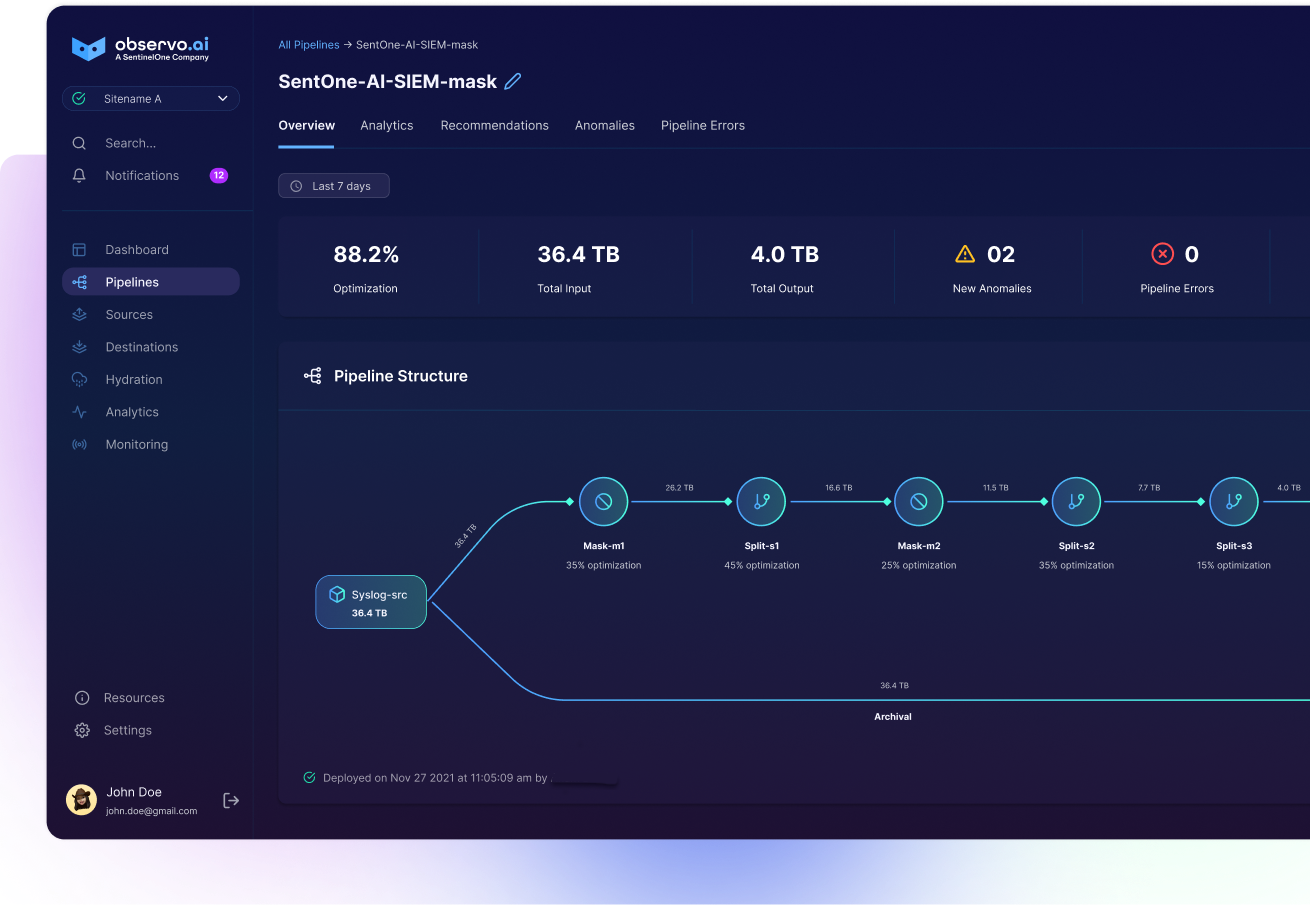Observability 101: Understanding OCSF: The Open Cybersecurity Schema Framework

What is OCSF?
Introduction
In an era where cyber threats are increasingly sophisticated and pervasive, the need for effective cybersecurity measures has never been more critical. Organizations are inundated with vast amounts of security data from various sources, making it challenging to integrate, analyze, and respond to threats efficiently. The Open Cybersecurity Schema Framework (OCSF) emerges as a solution to these challenges, offering a standardized approach to cybersecurity data representation. This blog post explores what OCSF is, its utility, how it can be used, the benefits it brings to the cybersecurity landscape, and how an AI-powered telemetry data pipeline like Observo AI can maximize the value of this approach.
What is OCSF?
The Open Cybersecurity Schema Framework (OCSF) is an open-source initiative aimed at creating a common language for cybersecurity data. It provides a standardized schema for representing cybersecurity information, enabling interoperability between different security tools and platforms. OCSF aims to simplify the process of aggregating, analyzing, and sharing security data across disparate systems.
Key Features of OCSF
- Standardization: OCSF defines a common schema that standardizes how cybersecurity data is structured and represented. This standardization ensures consistency in data interpretation across different tools and platforms.
- Interoperability: By providing a common schema, OCSF facilitates seamless data exchange between various security products and services. This interoperability is crucial for building an integrated and cohesive security infrastructure.
- Extensibility: OCSF is designed to be extensible, allowing organizations to customize and extend the schema to meet their specific needs. This flexibility ensures that OCSF can adapt to evolving cybersecurity challenges and requirements.
- Open Source: As an open-source initiative, OCSF encourages community participation and collaboration. This openness fosters innovation and ensures that the framework evolves to meet the needs of the cybersecurity community.
How is OCSF Useful?
- Enhanced Data Integration: One of the primary challenges in cybersecurity is integrating data from multiple sources. Different security tools generate data in various formats, making it difficult to correlate and analyze information. OCSF addresses this challenge by providing a unified schema that standardizes data representation. This standardization simplifies the integration of data from different sources, enabling more comprehensive and accurate threat analysis.
- Improved Threat Detection and Response: With standardized data, security analysts can more easily correlate events and identify patterns indicative of potential threats. OCSF enables faster and more effective threat detection by ensuring that data from different tools can be seamlessly combined and analyzed. This improved visibility into the security landscape enhances an organization's ability to respond to incidents promptly.
- Streamlined Security Operations: Security operations teams often struggle with the complexity of managing multiple security tools and platforms. OCSF simplifies this task by providing a common language for security data. This simplification reduces the learning curve for analysts and allows them to focus on high-value tasks rather than dealing with data inconsistencies and integration issues.
- Enhanced Collaboration: In many organizations, different teams use different security tools, leading to siloed information and fragmented security efforts. OCSF promotes collaboration by enabling consistent data exchange between teams and tools. This consistency ensures that all stakeholders have access to the same information, facilitating coordinated and effective security operations.
- Vendor-Neutral Approach: OCSF is vendor-neutral, meaning it is not tied to any specific security product or service. This neutrality ensures that organizations can adopt the framework regardless of their existing security infrastructure. It also promotes a healthy ecosystem of interoperable security solutions, giving organizations the flexibility to choose the best tools for their needs.
How to Use OCSF
- Understanding the Schema: Start by familiarizing yourself with the OCSF schema. The schema documentation provides detailed information on the data structures and field definitions used in OCSF. Understanding this schema is crucial for effectively integrating it with your existing security tools.
- Mapping Existing Data: Analyze the data generated by your current security tools and map it to the OCSF schema. This mapping process involves identifying the fields in your data and matching them to the corresponding fields in the OCSF schema. This step ensures that your data aligns with the standardized format defined by OCSF.
- Implementing Data Transformation: Once you have mapped your existing data to the OCSF schema, implement data transformation processes to convert your data into the standardized format. This can be done using scripts, data transformation tools, or by configuring your security tools to output data in the OCSF format directly.
- Integrating with Security Tools: Integrate the transformed data with your security tools and platforms. This integration allows you to leverage the standardized data for enhanced analysis, threat detection, and response. Many security tools provide APIs or plugins that facilitate this integration process.
- Leveraging OCSF for Analysis: Use the standardized data to perform more comprehensive and accurate threat analysis. With data from different sources now in a common format, you can correlate events, identify patterns, and gain deeper insights into your security landscape. Utilize your security information and event management (SIEM) systems, analytics platforms, and other tools to analyze the OCSF-formatted data.
- Extending the Schema: If your specific needs are not fully covered by the default OCSF schema, consider extending it. You can add custom fields and structures to accommodate unique data types and requirements. The extensibility of OCSF ensures that it can adapt to your organization's evolving cybersecurity needs.
Benefits of Using OCSF
- Consistency and Accuracy: By standardizing data representation, OCSF ensures that security information is consistently and accurately interpreted across different tools. This consistency reduces the risk of misinterpretation and errors in threat analysis.
- Efficiency: OCSF streamlines the process of integrating and analyzing security data, reducing the time and effort required to manage and correlate information from multiple sources. This efficiency translates into faster threat detection and response times.
- Cost Savings: Implementing OCSF can lead to cost savings by reducing the need for custom data integration solutions and minimizing the resources required for managing security data. Organizations can leverage the standardized schema to build more efficient and cost-effective security operations.
- Future-Proofing: As cyber threats evolve, the ability to adapt to new challenges is crucial. OCSF's extensible nature ensures that the framework can evolve to meet future cybersecurity needs. Organizations adopting OCSF are better positioned to adapt to emerging threats and technologies.
- Community Collaboration: Being an open-source initiative, OCSF benefits from community collaboration. Security experts and organizations can contribute to the framework, share best practices, and continuously improve the schema. This collaborative approach ensures that OCSF remains relevant and effective in addressing current and future cybersecurity challenges.
Conclusion
The Open Cybersecurity Schema Framework (OCSF) represents a significant advancement in the field of cybersecurity. By providing a standardized and extensible schema for cybersecurity data, OCSF addresses the challenges of data integration, interoperability, and consistency. Its benefits include enhanced threat detection and response, streamlined security operations, and cost savings. As an open-source initiative, OCSF encourages collaboration and innovation, ensuring that it continues to evolve to meet the needs of the cybersecurity community. Adopting OCSF can help organizations build a more cohesive, efficient, and effective security infrastructure, better equipped to defend against the ever-growing landscape of cyber threats.
Observo AI supports OCSF. Our AI-powered telemetry pipeline can transform almost any data source into the OCSF schema. We can use our advanced machine learning models to surface anomalies in the telemetry stream before data is ingested into a SIEM or other analytics platform. We can enrich this data for deeper context and highlight events that might lead to more serious incidents, typically resolving those incidents more than 40% faster. We can summarize normal data to dramatically reduce the data volume ingested to help you control costs and limit daily overage charges. We can typically reduce data by 80% or more, saving you money and allowing you to fit more data into your analytics tools for a complete picture of security. For more information on how we add value to SIEMs and other security tools, read our white paper, “The Easiest Way to Add or Evaluate a New SIEM.”




